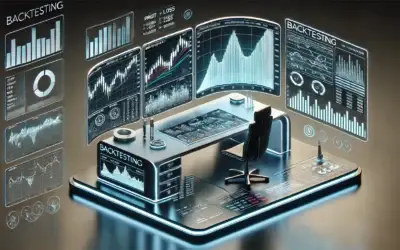In this post, we’ll explore why combining technical and fundamental analysis is crucial for prop traders, how to effectively integrate both approaches, and practical tips to help you leverage this combined strategy in your trading.
Why Combining TA and FA is Important
Relying solely on one form of analysis can limit your ability to make well-rounded trading decisions. Technical analysis provides insight into price trends and market behavior, while fundamental analysis delves into the economic factors and news events that drive those trends. By combining both approaches, you can develop a deeper understanding of the market, helping you make more informed decisions and reduce your risk.
Key Benefits of Combining Both Approaches:
Holistic Market View: Technical analysis shows you what’s happening in the market, while fundamental analysis helps you understand why it’s happening. Together, they give you a fuller picture of the market.
Improved Timing: Technical analysis can help you time your trades more precisely, while fundamental analysis ensures you’re trading in the right direction based on economic trends.
Enhanced Risk Management: By using both types of analysis, you can avoid falling into the trap of overconfidence in a single indicator or signal.
Example: A trader might use fundamental analysis to identify that the U.S. dollar is likely to strengthen due to rising interest rates. However, technical analysis can help pinpoint the best entry point to take advantage of that trend by identifying support and resistance levels.
Understanding Technical Analysis
Technical analysis focuses on historical price data and trading volume to predict future price movements. It involves analyzing charts, patterns, and indicators to identify trends and potential trading opportunities. Here’s how technical analysis can be applied effectively in trading:
Using Charts and Indicators
Charts are the foundation of technical analysis, and there are various types of charts—such as line charts, bar charts, and candlestick charts—that traders use to visualize price movements. Indicators, such as moving averages, the Relative Strength Index (RSI), and Bollinger Bands, help traders identify trends, reversals, and potential entry or exit points.
Example: A trader might use the 50-day moving average to identify the overall trend direction. If the price is consistently above the moving average, it signals an uptrend, while a price below the moving average indicates a downtrend.
Suggested links:
Trading Indicators: RSI, MACD, And Moving Averages
Recognizing Patterns
Chart patterns, such as head and shoulders, double tops and bottoms, and triangles, provide visual clues about future price movements. Recognizing these patterns can help traders predict potential breakouts or reversals.
Tip: Learn to recognize key patterns on your charts and use them to confirm your entry and exit points.
Identifying Support and Resistance Levels
Support and resistance levels are critical in technical analysis. Support is a price level where an asset tends to find buying interest, while resistance is a price level where selling pressure often emerges. These levels help traders decide where to place stop-loss orders and when to take profits.
Example: A trader might place a buy order near a strong support level, anticipating that the price will bounce back up from that level.
Understanding Fundamental Analysis
Fundamental analysis, on the other hand, involves evaluating the underlying economic, political, and social factors that influence currency prices. This type of analysis helps traders understand the broader market context and anticipate long-term price movements based on macroeconomic data and news events.
Monitoring Economic Indicators
Key economic indicators, such as GDP growth, employment data, inflation rates, and central bank interest rate decisions, play a significant role in driving currency prices. By staying informed about these indicators, traders can make more informed decisions.
Example: If a country’s central bank raises interest rates, it often strengthens that country’s currency because higher rates attract foreign investment.
Following Geopolitical Events
Geopolitical events, such as elections, trade agreements, and conflicts, can also have a major impact on currency markets. Traders who pay attention to these events can position themselves to capitalize on resulting market volatility.
Tip: Keep an eye on the economic calendar for key events, such as central bank meetings or election dates, and adjust your trading strategy accordingly.
Analyzing Market Sentiment
Market sentiment reflects the overall mood of traders and investors toward a particular currency or market. Sentiment can be influenced by news headlines, analyst reports, or global events. Fundamental analysis helps traders gauge whether market sentiment aligns with the economic outlook.
Example: If market sentiment is bullish on the U.S. dollar due to positive economic reports, a trader might look for technical signals that confirm a buying opportunity.
How to Combine Technical and Fundamental Analysis in Trading
Successfully combining technical and fundamental analysis involves understanding how both approaches complement each other. Here are practical steps to help you integrate them into your trading strategy:
Start with a Fundamental Analysis Framework
Begin by analyzing the macroeconomic environment to identify the broader trends that are likely to influence the currency pair you’re trading. Use fundamental analysis to determine the overall direction of the market—whether a currency is likely to strengthen or weaken.
Example: If your fundamental analysis indicates that the European Central Bank is likely to cut interest rates, you might anticipate a weakening of the euro.
Use Technical Analysis for Timing
Once you have a fundamental view, use technical analysis to refine your entry and exit points. Technical indicators and chart patterns can help you identify the best times to enter or exit trades based on price action.
Tip: If your fundamental analysis suggests a currency will strengthen, wait for technical signals, such as a breakout above resistance, to confirm your entry.
Monitor News and Events for Confirmation
Keep track of key news events and economic data releases that could validate or challenge your fundamental analysis. Adjust your technical strategy accordingly to reflect new information.
Example: If an upcoming central bank announcement could impact the market, wait for the news to be released and then look for technical signals that align with the market’s reaction.
Be Flexible and Adaptable
Markets are dynamic, and combining both forms of analysis requires flexibility. Be prepared to adjust your strategy if the fundamental or technical outlook changes. Don’t rely too heavily on one form of analysis—let them work together to guide your decisions.
Tip: If your technical analysis signals a strong trade but the fundamentals don’t support it, consider sitting out or lowering your risk exposure.
Conclusion
Combining technical and fundamental analysis gives prop traders a well-rounded approach to trading, allowing for better-informed decisions and more consistent performance. By understanding the broader economic context through fundamental analysis and fine-tuning your trades with technical analysis, you can create a powerful strategy that leverages the strengths of both approaches.




